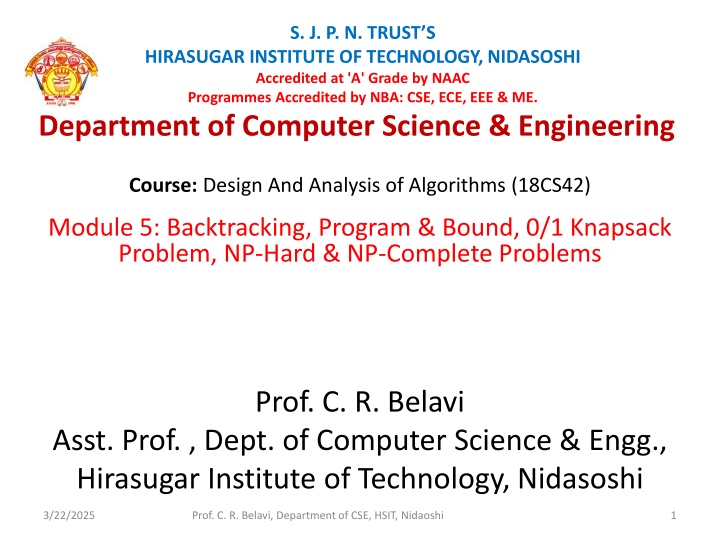
Analysis of Backtracking Method in Algorithm Design
Explore the backtracking method in algorithm design, focusing on constructing solutions one component at a time and utilizing state-space trees for optimization. Understand how backtracking efficiently solves complex problems by evaluating legitimate options for solution components. Dive into the principles behind backtracking for NP-Hard and NP-Complete problems.
Download Presentation

Please find below an Image/Link to download the presentation.
The content on the website is provided AS IS for your information and personal use only. It may not be sold, licensed, or shared on other websites without obtaining consent from the author. If you encounter any issues during the download, it is possible that the publisher has removed the file from their server.
You are allowed to download the files provided on this website for personal or commercial use, subject to the condition that they are used lawfully. All files are the property of their respective owners.
The content on the website is provided AS IS for your information and personal use only. It may not be sold, licensed, or shared on other websites without obtaining consent from the author.
E N D
Presentation Transcript
S. J. P. N. TRUSTS HIRASUGAR INSTITUTE OF TECHNOLOGY, NIDASOSHI Accredited at 'A' Grade by NAAC Programmes Accredited by NBA: CSE, ECE, EEE & ME. Department of Computer Science & Engineering Course: Design And Analysis of Algorithms (18CS42) Module 5: Backtracking, Program & Bound, 0/1 Knapsack Problem, NP-Hard & NP-Complete Problems Prof. C. R. Belavi Asst. Prof. , Dept. of Computer Science & Engg., Hirasugar Institute of Technology, Nidasoshi 3/22/2025 Prof. C. R. Belavi, Department of CSE, HSIT, Nidaoshi 1
Module 5 Backtracking 1. General Method (T2:7.1) 2. n-Queens Problem (T1:12.1) 3. Sum of Subset Problem (T1:12.1) 4. Graph coloring (T2:7.4) 5. Hamiltonian Cycle (T2:7.5) Prof. C. R. Belavi, Department of CSE, HSIT, Nidaoshi 3/22/2025 2
Backtracking General Method The desired solution is expressible as an n-tuple (x1, ..,xn), where the xi are chosen from some finite set Si Often the problem to be solved calls for finding one vector that maximizes ( or minimizes or satisfies ) a criterion function P(x1, ..,xn) Sometimes it seeks all vectors that satisfy P Suppose m is the size of set Si, then there are m = m1m2 .mn, n-tuples that are possible candidates for satisfying the function P Its basic idea is to build up the solution vector one component at a time and to use modified criterion function Pi(x1, x2 , ,xi) (sometimes called bounding function) to test whether the vector being formed has any chance to of success Major advantages of this method is this if it is realized that the partial vector (x1, x2 , .,xi) can in no way lead to an optimal solution, then mi+1 .mn possible test vectors can be ignored entirely Prof. C. R. Belavi, Department of CSE, HSIT, Nidaoshi 3/22/2025 3
Backtracking General Method The principle idea is to construct solutions one component at a time and evaluate such partially constructed candidates as follows If a partially constructed solution can be developed further without problem s constraints, it is done by taking the first remaining legitimate option for the next component If there is no legitimate option for the next component, no alternatives for any remaining component need to be considered violating the Prof. C. R. Belavi, Department of CSE, HSIT, Nidaoshi 3/22/2025 4
Backtracking General Method In this case, the algorithm backtracks to replace the last component of the partially constructed solution with its next option This kind of backtracking is implemented by constructing a tree called as state-space tree(SST) In SST, its root represent an initial state before the search for a solution begins The nodes of first level in the SST represent the choices made for the first component of a solution The nodes of the second level represent the choices for the second component and so on Prof. C. R. Belavi, Department of CSE, HSIT, Nidaoshi 3/22/2025 5
Module - 5 Backtracking n-Queens Problem Mr. C. R. BELAVI Dept. of CSE, HIT, Nidasoshi Prof. C. R. Belavi, Department of CSE, HSIT, Nidaoshi 3/22/2025 6
n-Queens Problem The problem is to place n queens on an n-by-n chessboard so that no TWO queens attack each other by being in the same row or in the same column or on the same diagonal For n=1, the problem has a trivial solution For n=2 and n=3, there is no solution So let us consider, n=4, i.e. four-queens problem and solve it by the backtracking technique Prof. C. R. Belavi, Department of CSE, HSIT, Nidaoshi 3/22/2025 7
State-Space Tree for n-Queens Problem Prof. C. R. Belavi, Department of CSE, HSIT, Nidaoshi 3/22/2025 8
Module - 5 Backtracking Sum of subset Problem Mr. C. R. BELAVI Dept. of CSE, HIT, Nidasoshi Prof. C. R. Belavi, Department of CSE, HSIT, Nidaoshi 3/22/2025 9
Sum of Subset Problem Find a subset of a given set S = { s1, s2, . sn } of n positive integers whose sum is equal to a given positive integer d For example, for S = { 1, 2, 5, 6, 8 } and d=9 Then there are two solutions:- Subset1 = { 1, 2, 6 } = 9 Subset2 = { 1, 8 } = 9 Of course, some instances of such problem is not possible i.e. if d=23 For convenient, all the set elements are sorted in increasing order as shown below- s1 s2 .. sn Prof. C. R. Belavi, Department of CSE, HSIT, Nidaoshi 3/22/2025 10
Sum of subset example S = { 3, 5, 6, 7 } and d = 15 Prof. C. R. Belavi, Department of CSE, HSIT, Nidaoshi 3/22/2025 11
Module - 5 Backtracking Graph Coloring Problem Mr. C. R. BELAVI Dept. of CSE, HIT, Nidasoshi Prof. C. R. Belavi, Department of CSE, HSIT, Nidaoshi 3/22/2025 12
Graph Coloring Let G be a graph and m be a given positive integer Then the nodes of graph G can be colored in such a way that no TWO adjacent nodes have the same color yet only m colors are used This is termed the m-colorability decision problem If d is the degree of graph, then it can be colored with d+1 colors The m-colorability optimization problem asks for the smallest integer m for which the graph G can be colored This integer is referred to as the chromatic number of the graph Prof. C. R. Belavi, Department of CSE, HSIT, Nidaoshi 3/22/2025 13
The above graph can be colored with three colors 1, 2 and 3 The color of each node is indicated next to it Three colors are needed to color this graph and hence this graph s chromatic number is 3 Prof. C. R. Belavi, Department of CSE, HSIT, Nidaoshi 3/22/2025 14
Graph Coloring Algorithm Prof. C. R. Belavi, Department of CSE, HSIT, Nidaoshi 3/22/2025 15
4-node Graph & all possible 3 coloring Prof. C. R. Belavi, Department of CSE, HSIT, Nidaoshi 3/22/2025 16
Module - 5 Backtracking Hamiltonian Cycle Mr. C. R. BELAVI Dept. of CSE, HIT, Nidasoshi Prof. C. R. Belavi, Department of CSE, HSIT, Nidaoshi 3/22/2025 17
Hamiltonian Cycle Let G = ( V, E ) be a connected graph wirh n vertices A Hamiltonian cycle is a round-trip path along n edges of G that visits every vertex once and returns to its starting position In other words if a Hamiltonian cycle begins at some vertex v1 G and the vertices of G are visited in the order v1,v2, .,Vn+1, then the edges (vi, vi+1) are in E, 1 i n, and the vi are distinct except for v1 and vn+1, which are equal Prof. C. R. Belavi, Department of CSE, HSIT, Nidaoshi 3/22/2025 18
Hamiltonian Cycle Algorithm Prof. C. R. Belavi, Department of CSE, HSIT, Nidaoshi 3/22/2025 19
Module - 5 Branch & Bound Mr. C. R. BELAVI Dept. of CSE, HIT, Nidasoshi Prof. C. R. Belavi, Department of CSE, HSIT, Nidaoshi 3/22/2025 20
Branch-and-Bound Branch-and-Bound is similar to backtracking, but it cut off a branch of the problem s state-space tree as soon as we can deduce that it cannot lead to a solution This idea is useful to find an optimization problem, one that seeks to minimize or maximize an objective function, usually subject to some constrains A feasible solution is a point in the problem s search space that satisfies all the problem s constraints While, an optimal solution is a feasible solution with the best value of the objective function Prof. C. R. Belavi, Department of CSE, HSIT, Nidaoshi 3/22/2025 21
Branch-and-Bound Algorithm Three reasons to terminate a search path at the current node in a state-space tree of a branch- and-bound algorithm- 1. The value of the node s bound is not better than the value of the best solution seen so far 2. The node represents no feasible solutions because the constraints of the problem are already violated 3. The subset of feasible solutions represented by the node consists of a single point ( and hence no further choices can be made ) Prof. C. R. Belavi, Department of CSE, HSIT, Nidaoshi 3/22/2025 22
Assignment Problem Statement Assignment problem is a problem of assigning n people to n jobs so that the total cost of the assignment is as small as possible An instance of the assignment problem is specified by an n-by-n cost matrix C so that we can state the problem as follows - select one element in each row of the matrix so that no two selected elements are in the same column and their sum is the smallest possible Prof. C. R. Belavi, Department of CSE, HSIT, Nidaoshi 3/22/2025 23
Assignment Problem Solution Prof. C. R. Belavi, Department of CSE, HSIT, Nidaoshi 3/22/2025 24
Assignment Problem Solution Prof. C. R. Belavi, Department of CSE, HSIT, Nidaoshi 3/22/2025 25
Assignment Problem- Optimal(Minimum) Solution a->2, b->1, c->3, d->4 = 2 + 6 + 1 + 4 = 13 Prof. C. R. Belavi, Department of CSE, HSIT, Nidaoshi 3/22/2025 26
BRANCH-AND-BOUND Knapsack Problem Given n items of known weights wi and the values vi, where i = 1, 2, 3, , n, and a knapsack of capacity W, find the most valuable subset of the items that fit in the knapsack For convenient, must arrange items in descending order by their value-to-weight ratios as shown in below example- Prof. C. R. Belavi, Department of CSE, HSIT, Nidaoshi 3/22/2025 27
Knapsack Problem Solution Prof. C. R. Belavi, Department of CSE, HSIT, Nidaoshi 3/22/2025 28
LC(Least Cost) Branch and Bound Solution To use branch and bound technique to solve any problem we need to construct state space tree for given problem As we know that 0/1 Knapsack problem is maximization problem(to get maximum profit), here we will solve it using minimization problem Clearly, pixi is maximized iff pixi is minimized This modified 0/1 knapsack problem is stated as below- Prof. C. R. Belavi, Department of CSE, HSIT, Nidaoshi 3/22/2025 29
For LCBB example - Consider the 0/1 Knapsack instance n=4,(p1,p2,p3,p4)=(10,10,12,18), (w1,w2,w3,w4)=(2,4,6,9) and m=15 Prof. C. R. Belavi, Department of CSE, HSIT, Nidaoshi 3/22/2025 30
For FIFOBB Example - Consider the 0/1 Knapsack instance n=4,(p1,p2,p3,p4)=(10,10,12,18), (w1,w2,w3,w4)=(2,4,6,9) and m=15 Prof. C. R. Belavi, Department of CSE, HSIT, Nidaoshi 3/22/2025 31
NP Complete and NP Hard Problems Basic Concept In this chapter we are concerned with the distinction between problems that can be solved by a polynomial time algorithm and problems for which no polynomial time algorithm is known For many of the problems we know and study, the best algorithms for their solutions have computing times that cluster into two groups First group consists of problems whose solution times are bounded by polynomial of small degrees. Examples- Searching(O(logn)), Sorting(O(nlogn)) Second group made up of problems whose best-known algorithms are non-polynomials. Examples- Travelling Salesman Problem(O(n22n)), Problems(O(2n/2)) Knapsack Prof. C. R. Belavi, Department of CSE, HSIT, Nidaoshi 3/22/2025 32
NP Complete and NP Hard Problems Basic Concept The theory of NP-completeness which we present here does not provide a method of obtaining polynomial time algorithms for problems in the second group Nor does it say that algorithms of this complexity do not exist Instead, what we do is show that many of the problems for which there are no known polynomial time algorithms are computationally related In fact, we establish two classes of problems These are given names NP-hard and NP-complete Prof. C. R. Belavi, Department of CSE, HSIT, Nidaoshi 3/22/2025 33
NP Complete and NP Hard Problems Basic Concept A problem that is NP-complete has the property that it can be solved in polynomial time if and only if all other NP-complete problems can also be solved in polynomial time If an NP-hard problem can be solved in polynomial time, then all NP-complete problems can be solved in polynomial time All NP-complete problems are NP-hard, but some NP-hard problems are not known to be NP- complete Prof. C. R. Belavi, Department of CSE, HSIT, Nidaoshi 3/22/2025 34
NP Complete and NP Hard Problems Non-Deterministic Algorithm Deterministic algorithm has the property that the result of every operation is uniquely defined Deterministic algorithms agrees with the way programs are executed on a computer Non-deterministic algorithm remove restriction on the outcome of every operation Also non-deterministic algorithm allow to contain operations whose outcomes are not uniquely defined but are limited to specified sets of possibilities Non-deterministic function introduces three new functions- 1. Choice(S) arbitrarily chooses one of the element of set S 2. Failure() signals an unsuccessful completion 3. Success() signals a successful completion Prof. C. R. Belavi, Department of CSE, HSIT, Nidaoshi 3/22/2025 35
Non-Deterministic Algorithms Prof. C. R. Belavi, Department of CSE, HSIT, Nidaoshi 3/22/2025 36
The Classes NP-hard and NP-complete P is the set of all decision problems deterministic algorithms in polynomial time NP is the set of all decision problems solvable by non- deterministic algorithms in polynomial time From below figure, its clear that NP- hard problems that are not NP- complete Only a decision problem can be NP- complete However, an optimization problem may be NP-hard Optimization problems cannot be NP- complete whereas decision problems can There also exist NP-hard decision problems that are not NP-complete solvable by Prof. C. R. Belavi, Department of CSE, HSIT, Nidaoshi 3/22/2025 37












